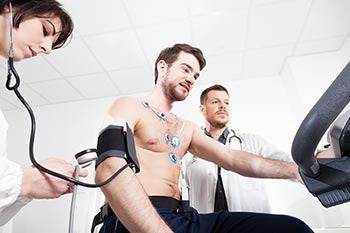Oneida Health
What is Stress Echocardiography
 Similar to the exercise treadmill testing, this test is performed while the patient exercises on a treadmill or stationary exercise bike. This test is also called an echocardiography stress test, or stress echo. During the stress echo, a doctor will monitor your blood pressure and heart rhythm during exercise to determine how well your heart and blood vessels are performing. Your heart will be brought to peak levels, or stressed, and then a doctor will take ultrasound images to determine if your heart is getting enough oxygen and blood while you exercise. The test can tell your doctor if you have had a heart attack, or if your chest pain is due to heart issues. The test can also reveal how well other treatments such as angioplasty, bypass grafting, or antiarrhythmic medications are working.
Similar to the exercise treadmill testing, this test is performed while the patient exercises on a treadmill or stationary exercise bike. This test is also called an echocardiography stress test, or stress echo. During the stress echo, a doctor will monitor your blood pressure and heart rhythm during exercise to determine how well your heart and blood vessels are performing. Your heart will be brought to peak levels, or stressed, and then a doctor will take ultrasound images to determine if your heart is getting enough oxygen and blood while you exercise. The test can tell your doctor if you have had a heart attack, or if your chest pain is due to heart issues. The test can also reveal how well other treatments such as angioplasty, bypass grafting, or antiarrhythmic medications are working.
Why the Test is Performed
Your doctor may use an echo test to look at your heart’s structure and check how well your heart is working. This test may be needed if:
- You have a heart murmur.
- You’ve had a heart attack.
- You have unexplained chest pains.
- You’ve had rheumatic fever.
- You have a congenital heart defect.
What Happens During the Test
Echo tests are done by trained sonographers.
- First a resting echocardiogram will be performed to get a baseline of your normal heart activity.
- You will lie on a bed on your left side or back.
- The sonographer will put special jelly on a probe and move it over your chest area.
- Ultra-high-frequency sound waves will pick up images of your heart and valves. No X-rays will be used.
- Your heart’s movements can be seen on a video screen.
- After the resting echocardiogram, your doctor next has you exercise on a treadmill or stationary bicycle. Depending on your physical condition, your doctor may ask you to increase the intensity of your exercise.
- You will exercise for 6 to 10 minutes, or until you feel tired, to raise your heart rate as much as possible.
- Tell your doctor right away if you feel dizzy or weak, or if you have chest pain or pain on your left side.
- As soon as your doctor tells you to stop exercising, another ultrasound will be performed. This is to take more images of your heart working under stress. You then have time to cool down. You can walk around slowly so that your heart rate can return to normal. Your doctor monitors your electrocardiogram (ECG), heart rate, and blood pressure until the levels return to normal.
- A videotape or a photograph can be made of the pictures.
- You can sometimes watch during the test.
- It usually takes one hour.
What the Test Results Show
- The size and shape of your heart
- How well your heart is working overall
- If a wall or section of heart muscle is weak and not working correctly
- If you have problems with your heart’s valves
- If you have a blood clot
If the results are normal, your heart is working properly and your blood vessels are probably not blocked due to coronary artery disease. Abnormal test results may mean that your heart isn’t pumping blood effectively because there’s a blockage in your blood vessels. Another reason could be that a heart attack damaged your heart. Diagnosing coronary artery disease and assessing your risk for heart attacks early on can help prevent future complications. This test can also help determine if your current cardiac rehabilitation plan is working for you.
How to Prepare for the Test
A stress echo normally takes between 45 and 60 minutes. Before you take the test, you should do the following:
- Make sure not to eat or drink anything for three to four hours before the test.
- Don’t smoke on the day of the test because nicotine can interfere with your heart rate.
- Don’t drink coffee or take any medications that contain caffeine without checking with your doctor.
- If you take medications, ask your doctor whether you should take them on the day of the test. You shouldn’t take certain heart medications, such as beta-blockers, isosorbide-dinitrate, isosorbide-mononitrate (Isordil Titradose), and nitroglycerin, before the test.
- Let your doctor know if you take medication to control diabetes as well.
- Wear comfortable, loose-fitting clothes. Because you will exercise, make sure to wear good walking or running shoes.
Potential Risks of the Test
Stress echocardiography is safe and non-invasive.